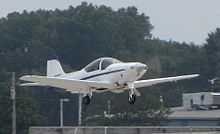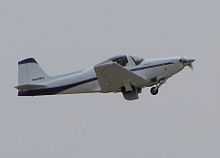Sequoia Falco


The Sequoia F.8L Falco is an Italian-designed lightweight 2-seater aerobatic aircraft.
Design and development
The aircraft was designed by the renowned Italian designer Stelio Frati[2] in 1955, and originally built in Italy by Aviamilano then Aeromere and later Laverda.
The Falco is currently sold in kit or plans form for amateur construction by the Sequoia Aircraft Company of Richmond, Virginia. The aircraft is single-engined, propeller driven and designed for private and general aviation use.[2][1]

The design was adopted in the US in the 1980s and converted to kit form. The aircraft is widely considered to be one of the best handling, strongest, and most aesthetically pleasing designs ever made available to home builders.[2]
Performance includes a 175 knot cruise speed and 6g aerobatic capability.[2]
The Sequoia Falco F8L is constructed of spruce and typically Finnish birch plywood. The structure is built from laminated spruce bulkheads and the birch plywood is used for the skin.[3] The plywood is often softened with hot steam, formed over the various structures and glued in place. The aircraft is rated for 6g positive and 3g negative.
Variants
- F.8L Series I
- Initial production model powered by 101 kW (135 hp) Lycoming engine. Ten built by Aviamilano.[4]
- F.8L Series II
- Improved model built by Aviamilano, with 112 kW (150 hp) engine.[4]
- F.8L America
- Modified version of Series II built by Aeromere in conformance with US airworthiness requirements.[4]
- Super Falco Series IV
- Similar to America, but with more powerful engine and constant speed propeller. Built by Laverda.[4]
- Sequoia 300
- The Falco with enlarged dimensions, re-designed for home-building from kits, by David Thurston of Lake Buccaneer fame.
- Sequoia 300
- A tandem trainer version of the Sequoia 300 intended for military use.
- Sequoia Kodiak
- A four seat cabin developpment of the Sequoia 300
Specifications (Laverda Super Falco Series IV)
Data from Jane's All The World's Aircraft 1965-66 [5]
General characteristics
- Crew: 2
- Length: 6.5 m (21 ft 4 in)
- Wingspan: 8.0 m (26 ft 3 in)
- Height: 2.27 m (7 ft 6 in)
- Wing area: 10.0 m² (107.5 sq ft)
- Airfoil: NACA 64213
- Aspect ratio: 6.4
- Empty weight: 550 kg (1,212 lb)
- Max. takeoff weight: 820 kg (1,808 lb)
- Powerplant: 1 × Lycoming O-320-B3B air-cooled flat-four, 119 kW (160 hp)
Performance
- Never exceed speed: 385 km/h (209 knots, 240 mph)
- Maximum speed: 325 km/h (176 knots, 202 mph) at sea level
- Cruise speed: 250 km/h (135 knots, 155 mph) (econ. cruise)
- Stall speed: 98 km/h (53 knots, 61 mph) (30 degree flaps)
- Range: 1,400 km (757 nmi, 870 mi)
- Service ceiling: 6,000 m (19,700 ft)
- Rate of climb: 5.0 m/s (984 ft/min)
See also
- Aermacchi SF.260 (military trainer designed by Frati)
- PAC CT/4 (Pacific Aerospace Limited)
Notes
- ↑ 1.0 1.1 Vandermeullen, Richard: 2011 Kit Aircraft Buyer's Guide, Kitplanes, Volume 28, Number 12, December 2011, page 69. Belvoir Publications. ISSN 0891-1851
- ↑ 2.0 2.1 2.2 2.3 Bayerl, Robby; Martin Berkemeier; et al: World Directory of Leisure Aviation 2011-12, page 118. WDLA UK, Lancaster UK, 2011. ISSN 1368-485X
- ↑ Jack Cox (September 1991). "Grand Champion Falco". Sport Aviation.
- ↑ 4.0 4.1 4.2 4.3 Taylor 1965, p.94.
- ↑ Taylor 1965, pp. 94–95.
References
- Taylor, John W. R. (1965). Jane's All The World's Aircraft 1965-66. London: Samson Low, Marston.
- Taylor, Michael J. H. (1989). Jane's Encyclopedia of Aviation. London: Studio Editions.
External links
| Wikimedia Commons has media related to Sequoia Falco. |
| |||||
| ||||||||||||||